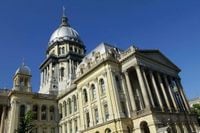Former California Governor Arnold Schwarzenegger has stepped into the national spotlight once again, this time to denounce what he calls a growing pattern of “cheating” in congressional redistricting efforts across the United States—a battle that’s heating up as the 2026 midterm elections approach. In a candid interview aired Sunday on CNN’s “State of the Union,” Schwarzenegger didn’t mince words: “There’s this war going on all over the United States. Who can out cheat the other one?” he told host Jake Tapper, lamenting how states have been leapfrogging each other in partisan mapmaking.
Schwarzenegger’s comments come amid a flurry of redistricting activity, with Republican lawmakers in states like Texas, Missouri, and North Carolina pushing to redraw congressional maps in a bid to bolster GOP control of the House. According to CNN, these efforts have already created seven new Republican-friendly districts this year alone, and states such as Indiana and Kansas are also weighing similar moves. The driving force behind much of this effort is President Donald Trump, who, in his second term, has made it clear he wants to keep Democrats from flipping the House in 2026.
But this isn’t a one-sided story. As Republicans work to shore up their advantage, Democratic-controlled states like California and Virginia are exploring their own redistricting maneuvers. In California, the high-stakes Proposition 50 is set for a November 4 special election. If approved by voters, the measure would allow Democrats to replace maps drawn by an independent commission with new lines that could help the party flip as many as five GOP-held House seats. Governor Gavin Newsom has called Prop 50 “foundational,” arguing that it’s time to “wake up to these new realities.” Responding to Schwarzenegger’s criticism, Newsom said, “Spare me the moral high ground.”
Schwarzenegger, who championed the ballot initiatives that created California’s independent redistricting commission, remains steadfast in his opposition. “To me, it’s all about competition,” he said, according to CNN. “That’s not really the way to go. One party should outperform the other party. It should be performance.” He acknowledged his friendship with Newsom and their ongoing discussions, but insisted that Democrats should “outperform Trump” at the ballot box, not through redistricting.
Meanwhile, the political chess match extends far beyond California’s borders. According to The Associated Press, President Trump’s push for redistricting has encountered unexpected resistance in two reliably red Midwestern states: Indiana and Kansas. Despite weeks of lobbying by the White House—including an Oval Office meeting for Indiana lawmakers and two trips to Indianapolis by Vice President JD Vance—Republican leaders in both states say they lack the votes needed to pass new, more GOP-friendly maps.
In Indiana, the state’s Senate has become a surprising roadblock. With only 10 Democrats in the 50-member chamber, more than a dozen of the 40 Republicans are reportedly unwilling to support mid-cycle redistricting. State Senate Leader Rodric Bray’s office told reporters that the votes simply aren’t there. Some lawmakers worry that tampering with district lines could inadvertently make safe Republican seats more competitive, while others object on principle. State Sen. Spencer Deery, a Republican, put it bluntly in an August statement: “We are being asked to create a new culture in which it would be normal for a political party to select new voters, not once a decade—but any time it fears the consequences of an approaching election.”
Indiana’s Lieutenant Governor Micah Beckwith, however, has urged lawmakers to press forward, criticizing the Senate for not being conservative enough. “For years, it has been said accurately that the Indiana Senate is where conservative ideas from the House go to die,” Beckwith posted on social media. The divide within the GOP highlights the state’s cautious political culture. As former GOP lawmaker Mike Murphy told The Associated Press, “Hoosiers, it’s very tough to predict us, other than to say we’re very cautious. We’re not into trends.”
Former Indiana Governor Mitch Daniels added his voice to the debate, urging lawmakers to resist the pressure for mid-decade redistricting. Writing in The Washington Post, Daniels argued, “Someone has to lead in climbing out of the mudhole. Hoosiers, like most Americans, place a high value on fairness and react badly to its naked violation.”
Kansas, too, finds itself at a crossroads. Republican legislative leaders are attempting to bypass Democratic Governor Laura Kelly and call a special session—a rare move in the state’s 164-year history—to pursue redistricting. The Kansas Constitution allows for such a session if two-thirds of both chambers sign a petition, the same supermajority needed to override a likely gubernatorial veto. While Republicans hold a slim supermajority, a handful of defections could sink the effort. As of late October, GOP leaders were still struggling to secure the final signatures needed.
Among the holdouts is Rep. Mark Schreiber, who told The Associated Press, “I did not sign a petition to call a special session, and I have no plans to sign one.” Schreiber believes redistricting should only occur after the decennial census, not mid-cycle. “Redistricting by either party in midcycle should not be done,” he said. Governor Kelly has also raised constitutional concerns about the timing of the effort.
The main target in Kansas is the 3rd Congressional District, represented by Democrat Sharice Davids, which includes Johnson County—home to more than 85% of the district’s voters and a region that has trended leftward since 2016. Republicans previously tried to redraw the district to weaken Davids’ chances, but she won comfortably in both 2022 and 2024. State Sen. Doug Shane, whose district includes part of Johnson County, said via email, “Splitting counties is not unprecedented and occurs in a number of congressional districts around the country.” Still, the state’s sizable contingent of moderate Republicans and unaffiliated voters, particularly in Johnson County, makes the outcome uncertain.
Partisan redistricting is hardly a new phenomenon. As Republican state Sen. Chris Garten of Indiana pointed out on social media, “For decades, Democrat states have gerrymandered in the dark of the night. We can no longer sit idly by as our country is stolen from us.” Supporters of aggressive redistricting argue that it’s simply fighting fire with fire, pointing to states like Massachusetts and Illinois as examples of Democratic gerrymandering. But for many lawmakers—on both sides of the aisle—the prospect of redrawing lines outside the normal census cycle feels like a step too far, threatening to undermine public trust in the electoral process.
As the special election in California approaches and legislative battles continue in Indiana and Kansas, the future of redistricting remains uncertain. Schwarzenegger’s call for “performance” over manipulation has struck a chord with some, while others insist that the stakes are too high to leave anything to chance. With both parties maneuvering for advantage, and voters watching closely, the outcome could shape not only the 2026 midterms but the very nature of American democracy for years to come.
In the end, whether through the ballot box or the backrooms of state legislatures, the battle over congressional maps is proving to be a defining fight—one where questions of fairness, power, and principle are all on the line.

